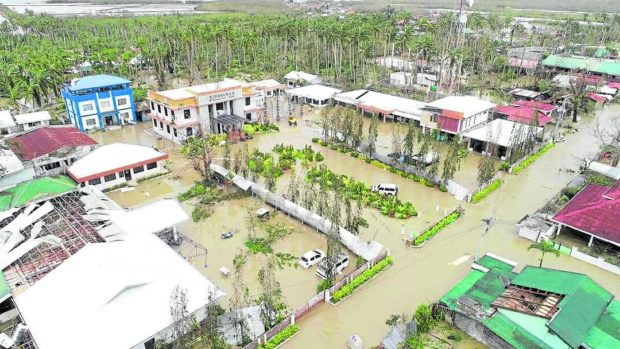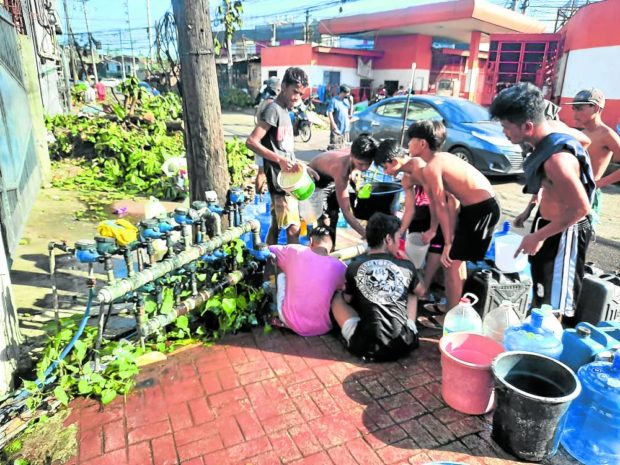Odette aftermath: Cry for aid rises in Visayas and Mindanao

FLOODED TOWN CENTER: Muddy floodwater still inundates the streets of the center of the Bohol provincial town of Inabanga on Saturday, two days after Typhoon Odette (international name: Rai) swept through the province. (Photo courtesy of Inabanga Councilor Jono Jumamoy)
CEBU CITY, Cebu, Philippines — Thousands of people in the Visayas and parts of Mindanao on Saturday appealed for food and water two days after Typhoon Odette (international name: Rai) wreaked havoc and left at least 76 people dead in the devastated regions, becoming the deadliest storm to hit the country this year.
Long lines formed on Saturday at gas and water refilling stations in at least three city centers—Cebu City; Tagbilaran City, capital of Bohol province; and Surigao City in northeastern Mindanao.
The typhoon’s fierce winds toppled power pylons, downing electric lines and causing widespread outages across the Visayas and northern Mindanao.
The outages are causing water supply interruptions because electric pumps which are used to distribute water to consumers are not running.

LUCKY LEAK: Residents of Cebu, desperate to find drinking water following the destruction caused by Typhoon Odette are lucky to find a leaking pipe in Barangay Labangon on Saturday. (NESTLE SEMILLA / Inquirer Visayas)
Long lines in Cebu
Shocked by the ferocity of the typhoon that caught many unprepared for its fierce winds, people in Cebu City filled up grocery stores to stock up on food and other essentials—the first time this has happened to this major Philippine city after the devastating Typhoon “Ruping” (Mike) in November 1990, locals said.
“We did not expect Odette to bring very strong winds. Of all the typhoons I have experienced, including Ruping, Odette had the strongest winds,” said Cebu City Councilor Dave Tumulak. “Ruping brought strong rains while Odette had strong winds. Both of them were devastating.”
Odette slammed first into Siargao Island on Thursday afternoon with 195-kilometer per hour winds and gusts of up to 270 kph. With no major landmass to cause a sharp weakening except for Bohol, by the time the typhoon hit Cebu later that night, it was packing 175-kph winds and gusts of 240 kph.
It blew out of the Philippine area of responsibility on Saturday afternoon with 165-kph winds and 205-kph gusts. It was moving at 25 kph toward the Kalayaan Island Group where forecasters raised Typhoon Signal No. 3, which means the area could experience destructive winds.
Bohol situation
In Bohol, a staffer of Rep. Erico Aristotle Aumentado who was distributing some noodles and bottled water said relief supplies were unable to reach the province’s worst-hit town of Ubay because roads were still unpassable due to fallen trees and electric poles.
Tagbilaran City Mayor Baba Yap responded to residents who asked for water on Facebook by sending water tankers.
Others, like Lito Alagadmo, 44, endured the long queue at Garcia Park near Bohol’s Provincial Capitol to get free water for his family.
“Water is what is important at this time, “ he said.
In Cebu City, a 32-year-old father walked almost 2 kilometers before he got lucky, finding a leaking water pipe in Barangay Labangon.
“I have a 1-year-old child. I needed water so we could cook rice. But there was no water in our village,” he told the Inquirer.
Landslides, floodwater, and storm debris that littered roads — fallen and uprooted trees, toppled power pylons, electric cables — are making it difficult for rescuers and those bringing relief supplies to reach communities in dire need of food and water.
Still no signal
The loss of cellular phone signals was also hampering rescue operations and the transmission of information to central authorities.
Majority of about 460,000 customers of Visayan Electric, the second largest power utility in the country next to Meralco, were still without power as of 3 p.m. on Saturday. Its service area covers the cities of Cebu, Mandaue, Talisay, and Naga as well as the towns of Liloan, Consolacion, Minglanilla, and San Fernando.
In a statement, the company said it would prioritize restoring electricity to hospitals, water providers, and other “vital institutions.”
Visayas deaths
According to data from various local disaster management offices, 61 people were killed in the typhoon across the Visayas. Cebu City reported 13 killed, adjacent Mandaue City had seven and six in Lapu-Lapu City on Mactan Island.
Negros Occidental reported 20 dead, six in Negros Oriental, three in Southern Leyte, one in Samar, two in Iloilo, two in Guimaras, and one in Bohol.
Among the fatalities were two patients — Junilyn Ferrer, 33, and Leonara Papa, 76 — who were in an ambulance that was swept away by a flash flood in Bais, Negros Oriental, while trying to get to the hospital on the eve of Odette’s landfall.
In Moises Padilla, Negros Occidental, 5-year-old Clareiz Solteda, died as she was pinned under a piece of wood when the typhoon blew her family’s house away on Friday.
Jose Ariel Valenzuela, 57, was found hanging from a tree with his neck caught between branches.
The authorities in Caraga (northeastern Mindanao) and Northern Mindanao reported that 15 people died, including 11 members of a family who were buried in a landslide at Barangay Kiayo in Sibagat town, Agusan del Sur province.
Two people died on Siargao Island, according to Surigao del Norte Gov. Francisco Matugas. A man was also reported to have died in San Fernando, Bukidnon, after a tree uprooted by the typhoon’s strong winds struck him and injured his two companions.
In the Dinagat Islands, where Odette made its second landfall, Gov. Arlene Bag-ao reported that there were a “few casualties” that were still being verified in the capital town of San Jose.
“The fields and boats of our farmers and fisherfolk have been decimated,” she said, adding that most of the province’s commercial and cargo vessels were now “unsuitable for sea voyages, effectively cutting us off from the rest of the country.”
Odette left a landscape that is “reminiscent if not worse than when ‘Yolanda’ (Haiyan) hit our province,” Bag-ao said, referring to the supertyphoon that struck in November 2013.
‘Yolanda Part 2’
The provincial government said Dinagat residents urgently needed food, water, temporary shelters, fuel, hygiene kits, and medical supplies.
“We may have survived, but we cannot do the same in the coming days because of our limited capacities as an island province. Through your help, we will be able to rise again,” she said.
Journalist Danilo Adorador called the devastation of Surigao City, the provincial capital of Surigao del Norte, “Yolanda Part 2.”
“No power, no running water, no internet signal. It’s safe to say everyone didn’t expect the damage to be this bad,” Adorador wrote on social media.
State of calamity
“Long lines of people in gas stations (most have been damaged and only few are open), several stores have been ransacked. People are roaming everywhere to find water,” Adorador wrote.
He said that road access was difficult as local authorities, still reeling from the disaster’s immediate impact, have yet to start removing debris.
Adorador appealed for food, water, shelter as many have lost homes and power generators.
In Butuan City, Caraga’s regional capital, local legislators declared a state of calamity on Dec. 17.
Odette affected 10 of the country’s 17 regions, according to the National Disaster Risk Reduction and Management Council.
As many as 364,501 people from Mimaropa, Western Visayas, Central Visayas, Eastern Visayas, Zamboanga Peninsula, Northern Mindanao and Caraga were preemptively evacuated. About 90 percent are still taking shelter at 2,283 evacuation centers.
It said 222 cities and municipalities in Mimaropa, Central Visayas, Eastern Visayas, Zamboanga Peninsula, Northern Mindanao (Regions 4B, 7, 8, 9, 10, respectively), and the Bangsamoro Administrative Region in Muslim Mindanao were without telecommunications services, and 193 cities and municipalities in nine regions lost electricity. Power was restored to only 21 percent, or 10 percent, on Saturday.